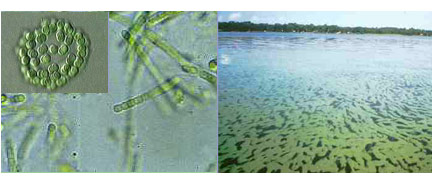|
|

|


|

^ Program

Microbial Ecology and Astrobiology
      
|
|
•
|
Photosynthetic Populations
|
•
|
Biogeochemical Cycling of Elements
|
•
|
Bioenergetics of Anaerobic Microorganisms
|
•
|
Lipid Biomarkers
|
|

|
Co-Leads:
David Des Marais, Leslie Bebout, Tori Hoehler, Linda Jahnke
|
Purpose
Studies of microbial ecosystems are important for students of astrobiology because these ecosystems are crucial for understanding the early evolution of life, as well as for devising effective strategies to search for evidence of life elsewhere in the cosmos. The evolution and survival of the early biosphere depended upon the efficient coordination of resources and processes by diverse microbial populations. Their study addresses Goals 4, 5 and 7 of the astrobiology roadmap.

The diversity of cyanobacteria, the organisms credited with discovering photosynthesis
|
Background
Microbial mats are important because their 3.4-billion-year fossil record makes them the oldest known ecosystems. Photosynthetic microbial mats are key because, today, sunlight powers more than 99 percent of global primary productivity. For most of Earth's history, photosynthetic ecosystems have affected the atmosphere profoundly and have created the most pervasive, easily detected fossils in ancient rocks. Therefore, those surface-dwelling biospheres on other planets that derived their energy principally from sunlight will be the ones most amenable to detection via telescopes or spacecraft.
Light sustains oxygenic as well as anoxygenic photosynthesis which, in turn, provides energy, organic substrates and oxygen to a microbial mat community. While photosynthetic bacteria might dominate the biomass and productivity of a microbial mat, many aspects of the emergent properties of this ecosystem ultimately reflect the activities of the associated nonphotosynthetic microbes, including the anaerobic populations. These nonphotosynthetic processes constitute the ultimate biological filter on chemical biomarkers (e.g., porphyrins, hopanes, isoprenoids and other biogenic hydrocarbons), and also chemical and isotopic biosignatures that are buried in sediments and subsequently enter the geologic fossil record. Also, the transformation of photosynthetic productivity by the microbial community can contribute diagnostic "biosignature" gases to planetary atmospheres that might be search targets for remote astronomical life detection efforts. To understand the overall structure and function of microbial mat communities, it is thus critical to determine the populations of photosynthetic and nonphotosynthetic microorganisms, both aerobic and anaerobic.
Research Plan
At Ames, we are documenting microbial populations using molecular methods, measuring their biogeochemical interactions, and examining the chemical and isotopic biosignatures that emerge. Also, a greenhouse-based growth facility can maintain microbial mats under conditions that were important on early Earth yet are difficult, if not impossible, to examine in naturally occurring environments today.
Students can work with any of several investigators to examine the following aspects of mats:
- Photosynthetic populations. Dr. Leslie Bebout is a well-known authority on cyanobacteria. She studies the relationships between the physical and chemical microenvironments of microbial mats and the populations of cyanobacteria that are present. This research will help us to understand how fossil remains have recorded signatures of cyanobacterial communities. Students can learn methods for manipulating a greenhouse environment to examine its effects upon the communities. They will also learn microscopy and molecular methods for the identification of microbiota.
- Biogeochemical cycling of elements. Dr. David Des Marais examines the processing of carbon- and oxygen-containing compounds in microbial mats, with the objective to understand the chemical processes that unite different microbial populations in microbial mats and create diagnostic biosignatures (e.g., chemicals, stable isotopes). Students can help the team to examine how environmental conditions affect the nature and flows of carbon compounds that, in turn, influence the biosignatures produced.
- Bioenergetics of anaerobic microorganisms. Dr. Tori Hoehler has extensive experience in elucidating the structure and function of microbial communities through a careful analysis of the thermodynamic "landscape" that controls their ability to harvest energy from their immediate environment. Dr. Hoehler's research provides a key basis for understanding which chemicals are produced and also can serve as gaseous biosignatures of these communities. Students can explore relationships between microenvironmental conditions, bioenergetics, and the mix of biosignature gases that emerge.
- Lipid biomarkers. Ms. Linda Jahnke is a widely recognized authority on the lipid molecules that can serve as biomarkers of microorganisms. She has studied both pure cultures and natural microbial mat communities and has made several discoveries of novel biomarker molecules. The students can learn methods for culture work and for detailed organic chemical analyses of microbial lipids. They can participate in the discovery of new lipid compounds, and they can understand how the stable isotopic compositions of these lipids reflect the metabolism and environment of the biota.
Participants
The Ames microbial ecology group offers opportunities for students to work on key problems in microbial ecology and to interact with a team of researchers. The microbial ecology team can accommodate up to two students per summer.
|
|

|

